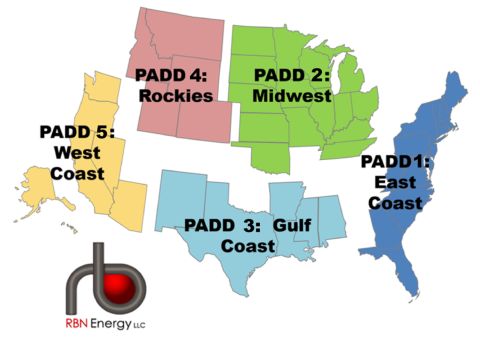The Rocky Mountain region (PADD 4), with a population that is both smaller and more spread out than other parts of the Lower 48, consumes only around 650 Mb/d of refined products — just one-fourth the volume of the next-smallest PADD. That limits the need for refinery capacity, which matches the region’s average annual consumption and is only outstripped in the summer months. Yet, the Shale Revolution has impacted the Rockies as much as any other region, boosting production in the Denver-Julesburg (DJ) and Uinta basins, and the Montana portion of the Bakken. At the same time, the area has also seen increasing volumes coming in from PADD 2 and Canada. In today’s RBN blog, we’ll look at how PADD 4 dispenses these barrels and its role in balancing continental crude oil supply and demand.
In Part 1 of this series, we explained how the U.S. is divided between five Petroleum Administration for Defense Districts, or PADDs (see Figure 1 below). With no production to call its own, PADD 1 relies on imported crude oil to supply its shrinking refinery base. But the East Coast’s population density also makes it the largest consumer of refined products. In Part 2, we put the spotlight on PADD 2 and how a 10% tariff on U.S. imports of Canadian crude oil could impact refineries in the Midwest and Great Plains. PADD 2 pipelines transport most Canadian exports, and its 25 refineries (combined capacity of 4.3 MMb/d) are, in many cases, significant consumers of heavy and light crudes from up north. In our PADD 3 blog, we looked at the critical role the Gulf Coast plays in crude oil and refined products markets, with its refineries being, on average, the most efficient and cost-advantaged in the world and its geography and infrastructure providing it ample export opportunities.
Figure 1. U.S. PADD Map. Source RBN
Today, we will look at PADD 4, the Rockies, a region without much refined product consumption but which has been expanding its crude oil production since the Shale Revolution. The five states in the Rockies consume about 650 Mb/d, which is evenly matched with its 644 Mb/d of in-region refinery capacity (see Figure 2 below). A little less than a third of that, 209 Mb/d, is in the Salt Lake City area, positioning “The Crossroads of the West” as PADD 4’s top refining center. Close behind is Billings, MT, host to 191 Mb/d of refinery capacity, which benefits from Canadian crude oil imports. The rest of the region’s capacity is spread across Colorado, Montana and Wyoming, with the largest refinery in the region being in Commerce City, CO. However, it is actually a combination of two or three smaller refineries, depending on how you count them.
Join Backstage Pass to Read Full Article









